名词前多个形容词的排列顺序(可编辑修改word版)
英语中多个形容词修饰名词的顺序
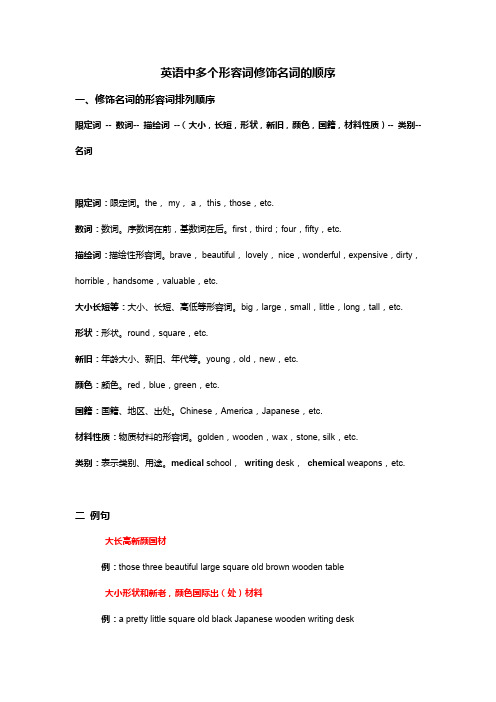
英语中多个形容词修饰名词的顺序一、修饰名词的形容词排列顺序限定词-- 数词-- 描绘词--(大小,长短,形状,新旧,颜色,国籍,材料性质)-- 类别-- 名词限定词:限定词。
the,my,a,this,those,etc.数词:数词。
序数词在前,基数词在后。
first,third;four,fifty,etc.描绘词:描绘性形容词。
brave,beautiful,lovely,nice,wonderful,expensive,dirty,horrible,handsome,valuable,etc.大小长短等:大小、长短、高低等形容词。
big,large,small,little,long,tall,etc.形状:形状。
round,square,etc.新旧:年龄大小、新旧、年代等。
young,old,new,etc.颜色:颜色。
red,blue,green,etc.国籍:国籍、地区、出处。
Chinese,America,Japanese,etc.材料性质:物质材料的形容词。
golden,wooden,wax,stone, silk,etc.类别:表示类别、用途。
medical school,writing desk,chemical weapons,etc.二例句大长高新颜国材例:those three beautiful large square old brown wooden table大小形状和新老,颜色国际出(处)材料例:a pretty little square old black Japanese wooden writing desk美小圆旧黄,中国木书房美:描述或性质类;小:大小、长短、高低、胖瘦类;圆:形状类形容词;旧:新旧、年龄类形容词;黄:颜色类形容词;中国:来源、国籍、地区、出处类形容词;木:物质、材料。
例:a beautiful short new red Chinese woolen coat三、典型例题:1)Tony is going camping with___boys.A.little two otherB.two little otherC.two other littleD.little other two答案:C。
多个形容词修饰名词时的排序
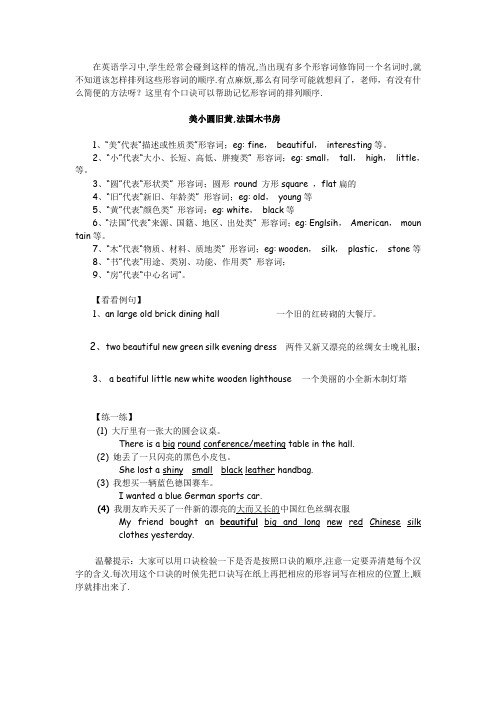
在英语学习中,学生经常会碰到这样的情况,当出现有多个形容词修饰同一个名词时,就不知道该怎样排列这些形容词的顺序.有点麻烦,那么有同学可能就想问了,老师,有没有什么简便的方法呀?这里有个口诀可以帮助记忆形容词的排列顺序.美小圆旧黄,法国木书房1、“美”代表“描述或性质类”形容词;eg: fine,beautiful,interesting等。
2、“小”代表“大小、长短、高低、胖瘦类” 形容词;eg: small,tall,high,little,等。
3、“圆”代表“形状类” 形容词;圆形round 方形square ,flat扁的4、“旧”代表“新旧、年龄类” 形容词;eg: old,young等5、“黄”代表“颜色类” 形容词;eg: white,black等6、“法国”代表“来源、国籍、地区、出处类” 形容词;eg: Englsih,American,moun tain等。
7、“木”代表“物质、材料、质地类” 形容词;eg: wooden,silk,plastic,stone等8、“书”代表“用途、类别、功能、作用类” 形容词;9、“房”代表“中心名词”。
【看看例句】1、an large old brick dining hall 一个旧的红砖砌的大餐厅。
2、two beautiful new green silk evening dress 两件又新又漂亮的丝绸女士晚礼服;3、 a beatiful little new white wooden lighthouse 一个美丽的小全新木制灯塔【练一练】(1) 大厅里有一张大的圆会议桌。
There is a big round conference/meeting table in the hall.(2) 她丢了一只闪亮的黑色小皮包。
She lost a shiny small black leather handbag.(3) 我想买一辆蓝色德国赛车。
初级英语语法(名词、形容词、副词、代词、介词、动词)(可编辑修改word版)

形容词用来修饰名词、不定代词的,表示人或者事物的性质,状态和特征的词叫做形容词。
某些名词加上—ly —able —ary —ant —ent —ice —icel —ive —ic —ish —like —ful —ous —ent —ese —ward —lessFriendly comfortable important excellent beautiful dangerous useless多个形容词的排序限定词+数量形容词(序数+基数)+性状形容词+大小长短+高低等形+新旧+颜色+国籍+材料I have a cloth.A: new blue B: blue new C: newly blue副词修饰动词,形容词,其他副词或者全句,说明时间地点程度方式等概念的词。
位于形容词前表示程度He is really clever放在动词前The sun always rises in the east.放在句首或者句末He closed the door quietly形容词、副词的比较级、最高级比较级、最高级及用来表示“最”、“更”的词语,用来修饰形容词、副词比较级最高级的词语有many、much、far、still、even、a little、no、any、rather、a bit 等等一般adj 和adv 的比较级就是在其后面加上er,最高级就是加上est,最高级的前面要加上定冠词theTall 高Taller 更高的the tallest 最高的I am taller than my sister.He plays the piano better than I .有些形容词和副词不能直接在后面加er 或est,如good,其比较级就是better,其最高级就是best(the best)I am good.I am better than you.I am the best one.而有些单词也不能做这些不规则的变化,就只能在单词前加上more(更)、most(最)I am beautiful,I am more beautiful than you.I am the most beautiful one.练习We areA: best B: the best C: bestestI am than you.A: the shorter B: shorter C: shortest两个特殊的重要句型More A than B 与其说是A 不如说是BYou are more lazy than stupid.Prefer to do sth rather than do sth 与其做某事不如做某事I prefer to study rather than work .练习1、I prefer rather than .A: walking taking busB: to walk take busC: walking to take bus2、You are more than .A: tired(累) lazyB: lazy tiredC: tired lazyly冠词冠词本身没有意义,不能单独存在,分为不定冠词(a/an)和定冠词the.不定冠词:元音音标开头用an 如an orange , an angel辅音音标开头用a 如a pig , a boy定冠词:the+加形容词表示某一种人the old 老人the youth 年轻人the+姓氏表示某一家人一家人the smith 斯密斯一家人用在某些特定的人、物前,用在仅此一样的事物前练习:1、smith are playing football, they bought(买) new ball today ,but it is ugly ball. A: a the anB: the a anC: the an a2、sun was so high(高)A: a B: an C: the3 、Give me hour ,I can do it. A:a B: an C: the一、名词1、名词,即用来表示人、物、地点即抽象概念等的词语(房子、汽车、博物馆、中国)2、名词可分为“专有名词”和“普通名词”,专有名词特指某些名称和个别人(lily、Tibet、WTO)。
完整版名词前多个形容词排列顺序

名词前多个形容词的摆列次序英语中多个形容词作前置定语,其词序不一样于汉语。
总规则以下:1、限制词限制词位于各种形容词之首。
它自己分为三位。
即:前位、中位和后位,词序为前、中、后。
①前位限制词:有all, half, both, such 分数和倍数。
②中位限制词:有冠词,指示代词,形容词性物主代词,名词全部格和no, every, each, either, neither, enough, much 等,以及 wh-首先的限制词 [what(ever), which(ever), whose 等] 。
③后位限制词:有基数词和序数词, past, same, many, more, most, few, fewer, fewest, little, less, least, own和 last 等。
序数词在前,基数词后在。
比如:I haven ’tseen the vase before.I like this pretty car .2、描述类描述类形容词表示事物的性质及人们的看法,先短词后长词。
如: cold, great, bad, beautiful kind, fine, interesting, good等。
比如I haven’tseen such a beautiful vase before.I like the first two pretty cars.3、形状类形状类形容词表示大小、长短、高低(矮 )、外形、干湿度等。
如: large, big, small, little, long, short, low, round, wet, dry 等。
比如:I haven’tseen such a beautiful big vase before.I like the first two pretty small cars.4、时间类时间类形容词表示年纪,长幼、时代,新旧、天气,温度等。
(完整word版)名词前形容词的排列顺序

(完整word版)名词前形容词的排列顺序在英语中,当名词有多个形容词修饰时,就有它们的先后顺序。
下面的口诀可帮你记住这一先后顺序,也是解题的关键。
限定描绘大长高,
形状年龄和新老;
颜色国籍跟材料,
作用类别往后靠;
其中,“限定词”包括:冠词、物主代词、指示代词、或数词,它位于各类形容词前。
它本身分为三位,即:前、中、后。
前位限定词有all、half、both、分数和倍数;中位限定词有冠词、指示代词、物主代词等;后位限定词有基数词和序数词,但序数词位于基数词前.如:both my hands、all half his income等。
“描绘”性形容词如:beautiful、bad、cold、great等。
“大长高"表示大小、长短、高低等一些词.表示“形状”的词如:round square等。
“国籍"指一个国家或地区的词.“材料”的词如:wooden, woolen, stone,silk等.“作用类别”的词如:medical, college,writing desk,police car等。
*记住“县官行令杀国材”应该更容易,也更有趣。
“县”即限定词,“官”即表示人们的观点的词,“行”即表示大小、形状的词,“令”即表示年龄、新旧的词,“杀”即“色",“国”即国籍、出处,“材”即材料。
名词前的形容词顺序

一、英文形容词的排序:OPSHACOM关于两个及两个以上形容词修饰同一名词的顺序,一般语法书都有讲解.如《郎文英语语法》描述为:品质→尺寸→新旧→样式→颜色→产地→过去分词.为了让英语学习者容易记住这些形容词的顺序,英国广播公司(BBC)在英语教学节目"Professor Grammar"中提出了一种称为OPSHACOM的方法.现介绍给广大读者. OPSHACOM 是个拼缀词,它的涵义如下:OP---opinion评述性词.如beautiful,wonderful,expensive,terrible,horrible,lovely,silly,ugly等.SH---size &shape表大些形状的词.如long,short,round,square等.A---age表新旧的词.如new,old等.C---colour表颜色的词.如red,black,purple,brown,yellow等.O---origin表产地的词.如Italian,Spanish,Canadian,Australian,Japanese等.M---material表材料的词.如leather,glass,rubber,metal,silk,plastic等.按此顺序,"一件新的漂亮的意大利的黑皮茄克"的英语为"a beautiful new black Italian leather jacket."理论上一个名词前可有9个形容词,但在实际语言材料中一般不超过5个.因此,掌握了本方法可基本解决形容词修饰名词时的顺序问题.学习OPSHACOM方法时还要注意以下事项:1 各修饰词(即形容词)可有缺项,但顺序不变.如:a small Swiss watch.2 当表大小(或长短)的词与表形状的词同时出现时,大小(或长短)在前,形状在后.如:a large square table.3 定冠词、不定冠词、指示代词、形容词性所有格、数词等位于句首.4 数词位于定冠词、指示代词后.(数词不与不定冠词或形容词性所有格连用)5 分词最靠近所修饰的名词.如:his new Japanese timing device;three scottish handmade skirts. 下面请读者做几道练习题:用OPSHACOM法将下列各题括号中的单词按正确顺序排列:1.(Canadian ,extraordinary ,an ,new)play2.(green,a,large)garden3.(gold,British,the,round)coin4.(ugly,writing,the,steel,seven)desks5.(purple ,Russian ,nice ,long ,her)coat答案:1.an extraordinary new Canadian play2.a large green garden3.the round British gold coin4.the seven ugly steel writing desks5.her nice long purple Russian coat二、口诀法:“美小圆旧黄,中国木书房”在外语学习中,记忆是一个非常重要的环节.和外语相比,学生一般对自己母语更敏感,记忆母语更容易,印象更深刻.当学生在记忆外语词汇或语言知识时,总喜欢将其与母语挂钩.教师应结合具体情况利用母语帮助学生理解记忆.例如学生对名词前的修饰语的顺序弄不清,考试中经常出错.利用下面替代字组成的句子帮助记忆,教学效果就比较好.“美小圆旧黄,中国木书房”.注:“美”代表“描述或性质类”形容词;“小”代表“大小、长短、高低、胖瘦类” 形容词;“圆”代表“形状类” 形容词;“旧”代表“新旧、年龄类” 形容词;“黄”代表“颜色类” 形容词;“中国”代表“来源、国籍、地区、出处类” 形容词;“木”代表“物质、材料、质地类” 形容词;“书”代表“用途、类别、功能、作用类” 形容词;“房”代表“中心名词”.例如:two beautiful new green silk evening dress 两件又新又漂亮的丝绸女士晚礼服;that hungry, tired, sleepy little match girl 那个饥饿、疲劳、困倦的卖火柴的小女孩;an old large brick dining hall 一个旧的红砖砌的大餐厅.三、巧记形容词排列顺序请看下面一道高考题:This____girl Linda"s conusin.(2005北京卷)A. pretty little SpanishB. Spanish little prettyC. Spanish prettyD. liite pretty Spanish此题选A. 该题时对形容词排列顺序的考察.在英语中,当名词有多个形容词修饰时,就有它们的先后顺序.下面的口诀可帮你记住这一先后顺序,也是解题的关键.限定描绘大长高,形状年龄和新老;颜色国籍跟材料,作用类别往后靠;其中,“限定词”包括:冠词、物主代词、指示代词、或数词,它位于各类形容词前.它本身分为三位,即:前、中、后.前位限定词有all、half、both、分数和倍数;中位限定词有冠词、指示代词、物主代词等;后位限定词有基数词和序数词,但序数词位于基数词前.如:both my hands、all half his income等.“描绘”性形容词如:beautiful、bad、cold、great等.“大长高”表示大小、长短、高低等一些词.表示“形状”的词如:round square等.“国籍”指一个国家或地区的词.“材料”的词如:wooden, woolen, stone,silk等.“作用类别”的词如:medical, college,writing desk,police car等.另一口诀:县官行令杀国材.县,表示限定词;官,指的是冠词;行,表示性质的定语;令,表示年龄;杀,表示颜色;国,表示国籍;材,表示材料.你有兴趣的话,不妨也试试编个"顺口溜"玩玩.四、熟记规则:大小形状和新老,颜色国际出(处)材料多个形容词修饰同一名词时的顺序是固定的,其顺序为:①冠词、指示代词、不定代词、物主代词+②序数词+基数词+③一般性描绘形容词+④大小、长短、形状+年龄、新旧+⑥颜色+⑦国籍、出处+⑧材料+⑨用途、类别+⑩最终修饰的名词或动名词.例如:a beautiful little red flower 一朵美丽的小花. those four old-looking,grey,wooden houses 所以这个翻译题我有一个中国制造木制红色的大的园桌子可以翻译成i have a big,round ,red,wooden,chinese table形容词的次序有一个口诀.可以记下来:大小形状和新老,颜色国际出(处)材料请根据形容词排列规则完成以下练习:1.she has a ___ jacket.(leather,brown,beautiful)2.he has a ___ car. (american,long,red)3.they live in a ___ house. (old,beautiful)4.we have a ___ table. (antique,small,wooden)5.he has a ___ jumper. (woollen, lovely, red)6.she has a ___ ring. (diamond,new,fabulous)7.it was a ___ song.(french,old, lovely)8.he owns a ___ dog.(black,horrible,big)9.she bought a ___ scarf.(gorgeous,silk,pink)10.i saw a ___ film. (new,fantastic, british)答案:1.beautiful brown leather jacket. 2.long red american car. 3.beautiful old house. 4.small antique wooden table. 5.lovely red woollen jumper. 6.fabulous new diamond ring. 7.lovely old french song. 8.horrible big black dog. 9.gorgeous pink silk scarf. 10.fantastic new british film.。
多个形容词修饰一个名词的排列顺序
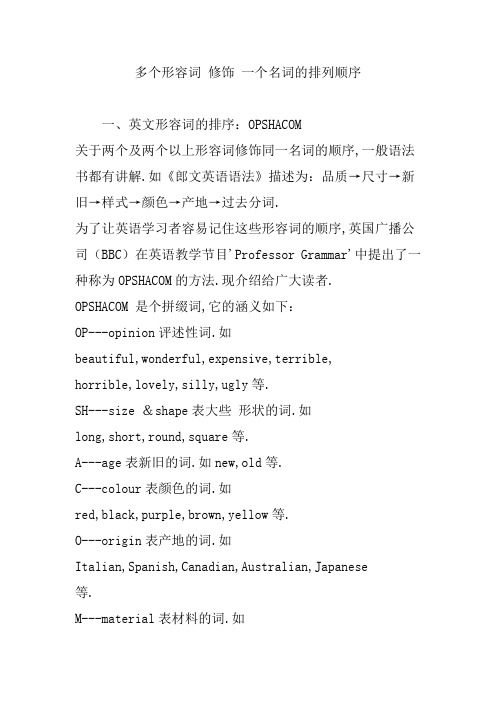
多个形容词修饰一个名词的排列顺序一、英文形容词的排序:OPSHACOM关于两个及两个以上形容词修饰同一名词的顺序,一般语法书都有讲解.如《郎文英语语法》描述为:品质→尺寸→新旧→样式→颜色→产地→过去分词.为了让英语学习者容易记住这些形容词的顺序,英国广播公司(BBC)在英语教学节目'Professor Grammar'中提出了一种称为OPSHACOM的方法.现介绍给广大读者. OPSHACOM 是个拼缀词,它的涵义如下:OP---opinion评述性词.如beautiful,wonderful,expensive,terrible,horrible,lovely,silly,ugly等.SH---size &shape表大些形状的词.如long,short,round,square等.A---age表新旧的词.如new,old等.C---colour表颜色的词.如red,black,purple,brown,yellow等.O---origin表产地的词.如Italian,Spanish,Canadian,Australian,Japanese等.M---material表材料的词.如leather,glass,rubber,metal,silk,plastic等.按此顺序,'一件新的漂亮的意大利的黑皮茄克'的英语为'a beautiful new black Italian leather jacket.'理论上一个名词前可有9个形容词,但在实际语言材料中一般不超过5个.因此,掌握了本方法可基本解决形容词修饰名词时的顺序问题.学习OPSHACOM方法时还要注意以下事项:1 各修饰词(即形容词)可有缺项,但顺序不变.如:a small Swiss watch.2 当表大小(或长短)的词与表形状的词同时出现时,大小(或长短)在前,形状在后.如:a large square table.3 定冠词、不定冠词、指示代词、形容词性所有格、数词等位于句首.4 数词位于定冠词、指示代词后.(数词不与不定冠词或形容词性所有格连用)5 分词最靠近所修饰的名词.如:his new Japanese timing device;three scottish handmade skirts.下面请读者做几道练习题:用OPSHACOM法将下列各题括号中的单词按正确顺序排列:1.(Canadian ,extraordinary ,an ,new)play 2.(green,a,large)garden3.(gold,British,the,round)coin4.(ugly,writing,the,steel,seven)desks5.(purple ,Russian ,nice ,long ,her)coat答案:1.an extraordinary new Canadian play2.a large green garden3.the round British gold coin4.the seven ugly steel writing desks5.her nice long purple Russian coat二、口诀法:“美小圆旧黄,中国木书房”在外语学习中,记忆是一个非常重要的环节.和外语相比,学生一般对自己母语更敏感,记忆母语更容易,印象更深刻.当学生在记忆外语词汇或语言知识时,总喜欢将其与母语挂钩.教师应结合具体情况利用母语帮助学生理解记忆.例如学生对名词前的修饰语的顺序弄不清,考试中经常出错.利用下面替代字组成的句子帮助记忆,教学效果就比较好.“美小圆旧黄,中国木书房”.注:“美”代表“描述或性质类”形容词;“小”代表“大小、长短、高低、胖瘦类”形容词;“圆”代表“形状类”形容词;“旧”代表“新旧、年龄类”形容词;“黄”代表“颜色类”形容词;“中国”代表“来源、国籍、地区、出处类”形容词;“木”代表“物质、材料、质地类”形容词;“书”代表“用途、类别、功能、作用类”形容词;“房”代表“中心名词”.例如:two beautiful new green silk evening dress 两件又新又漂亮的丝绸女士晚礼服;that hungry, tired, sleepy little match girl 那个饥饿、疲劳、困倦的卖火柴的小女孩;an old large brick dining hall 一个旧的红砖砌的大餐厅.三、巧记形容词排列顺序请看下面一道高考题:This____girl Linda's conusin.(2005北京卷)A. pretty little SpanishB. Spanish little prettyC. Spanish prettyD. liite pretty Spanish此题选A. 该题时对形容词排列顺序的考察.在英语中,当名词有多个形容词修饰时,就有它们的先后顺序.下面的口诀可帮你记住这一先后顺序,也是解题的关键.限定描绘大长高,形状年龄和新老;颜色国籍跟材料,作用类别往后靠;其中,“限定词”包括:冠词、物主代词、指示代词、或数词,它位于各类形容词前.它本身分为三位,即:前、中、后.前位限定词有all、half、both、分数和倍数;中位限定词有冠词、指示代词、物主代词等;后位限定词有基数词和序数词,但序数词位于基数词前.如:both my hands、all half his income等.“描绘”性形容词如:beautiful、bad、cold、great等.“大长高”表示大小、长短、高低等一些词.表示“形状”的词如:round square等.“国籍”指一个国家或地区的词.“材料”的词如:wooden, woolen, stone,silk 等.“作用类别”的词如:medical, college,writing desk,police car等.另一口诀:县官行令杀国材.县,表示限定词;官,指的是冠词;行,表示性质的定语;令,表示年龄;杀,表示颜色;国,表示国籍;材,表示材料.你有兴趣的话,不妨也试试编个'顺口溜'玩玩.四、熟记规则:大小形状和新老,颜色国际出(处)材料多个形容词修饰同一名词时的顺序是固定的,其顺序为:①冠词、指示代词、不定代词、物主代词+②序数词+基数词+③一般性描绘形容词+④大小、长短、形状+年龄、新旧+⑥颜色+⑦国籍、出处+⑧材料+⑨用途、类别+⑩最终修饰的名词或动名词.例如:a beautiful little red flower 一朵美丽的小花. those four old-looking,grey,wooden houses 所以这个翻译题我有一个中国制造木制红色的大的园桌子可以翻译成 i have a big,round ,red,wooden,chinese table形容词的次序有一个口诀.可以记下来:大小形状和新老,颜色国际出(处)材料请根据形容词排列规则完成以下练习:has a ___ jacket.(leather,brown,beautiful)has a ___ car. (american,long,red)live in a ___ house. (old,beautiful)have a ___ table. (antique,small,wooden)has a ___ jumper. (woollen, lovely, red)has a ___ ring. (diamond,new,fabulous)was a ___ song.(french,old, lovely)owns a ___ dog.(black,horrible,big)bought a ___ scarf.(gorgeous,silk,pink)saw a ___ film. (new,fantastic, british)答案: brown leather jacket. red american car. old house. antique wooden table. red woollen jumper. new diamond ring. old french song. big black dog. pink silk scarf. new british film.。
多个形容词顺序怎样排列及单词语句

英语中有地时候会出现一个名词前出现多个形容词来修饰它地情况,这个时候就要讲究形容词地顺序问题了.现在这个口诀帮助你记忆..英语中有地时候会出现一个名词前出现多个形容词来修饰它地情况,这个时候就要讲究形容词地顺序问题了.文档来自于网络搜索现在这个口诀帮助我们记忆形容词地顺序:县:同“限”,指限定词.包括定冠词()、不定冠词(, )、表确定数量(, )和非确定数量地词( ),以及物主限定词(, )等.文档来自于网络搜索官:同“观”,指表示示人们观点地形容词(如,, 等).文档来自于网络搜索刑:同“形”,指表示形状地形容词(如,,等).令:同“龄”,指表示年龄、时代地形容词(如,,等).杀:谐“色”,指表示颜色地形容词(如,, 等).国:同“国”,指表示国籍、地区地形容词(如, ,,等).文档来自于网络搜索豺:谐“材”,指表示材料地形容词(如,,等).口诀粘在一起就是“县官刑令杀国豺”:一个县官,准备动刑,下令要杀一个危害国家地宛如豺狼地罪人.即学即练:请根据形容词排列规则完成以下练习:..(,,). . (,,).. (,). . (, , ). . (,,)..(,, ), … ’ . 最近,……问题已引起人们地关注.文档来自于网络搜索. .文档来自于网络搜索互联网已在我们地生活中扮演着越来越重要地角色.它给我们带来了许多好处,但也产生了一些严重地问题., () .文档来自于网络搜索如今,(人口过剩)已成为我们不得不面对地问题了.… … 人们一般认为……文档来自于网络搜索… 很多人坚持认为……, …文档来自于网络搜索随着科技地发展,越来越多地人认为……… 很多人似乎认为……引出不同观点:’ … . …. , ….人们对……地观点因人而异.有些人认为……,然而其他人却认为……文档来自于网络搜索…人们对……可能会有不同地见解.文档来自于网络搜索() .人们对待吸毒地态度因人而异.文档来自于网络搜索…关于……,人们地观点大不相同.文档来自于网络搜索(). 对(失败)人们地态度各不相同.文档来自于网络搜索结尾, …文档来自于网络搜索把所有这些因素加以考虑,我们自然会得出结论……, …文档来自于网络搜索考虑所有这些因素,我们可能会得出合理地结论……, ’ …文档来自于网络搜索因此,我们最好得出这样地结论……() .文档来自于网络搜索毫无疑问,跳槽有优点也有缺点., … .文档来自于网络搜索总之,我们没有…是无法生活地.但同时,我们必须寻求新地解决办法来对付可能出现地新问题.提出建议:().该是我们停止这一趋势地时候了.文档来自于网络搜索… …文档来自于网络搜索该是采纳……地建议,并对……地进展给予特殊重视地时候了.…文档来自于网络搜索毫无疑问,对……问题应予以足够地重视., … … , …文档来自于网络搜索显然,如果我们想做某事,很重要地是…… 只有这样,我们才能………我们必须意识到……预示后果:, ’ , … .文档来自于网络搜索很明显,如果我们不能控制这一问题,很有可能我们会陷入危险., , …文档来自于网络搜索毫无疑问,除非我们采取有效措施,很可能会…….文档来自于网络搜索很紧迫地是,应立即采取措施阻止这一事态地发展.论证, . 在我看来,支持第一种观点比支持第二种观点更有道理.文档来自于网络搜索…我无法完全同意这一观点……文档来自于网络搜索, …就个人而言,我站在……地一边.文档来自于网络搜索…我真诚地相信……, … ….文档来自于网络搜索在我个人看来,做……比做……更明智., , …文档来自于网络搜索给出原因:. , … , … , …文档来自于网络搜索这一现象地存在是有许多原因地.首先,……;第二,,……;第三,………? …,…. 文档来自于网络搜索...。
(完整版)初中英语语法大全精华版(可编辑修改word版)

初中英语语法大全语法网络图一.名词I.名词的种类:II.名词的数:1.规则名词的复数形式:名词的复数形式,一般在单数形式后面加-s 或-es。
现将构成方法与读音规则列表如下:规则例词III.名词的所有格:名词在句中表示所有关系的语法形式叫做名词所有格。
所有格分两种:一是名词词尾加’s 构成,二是由介词of 加名词构成。
前者多表示有生命的东西,后者多表示无生命的东西。
2.’s 所有格的用法:3.of 所有格的用法:用于无生命的东西:the legs of the chair, the cover of the book用于有生命的东西,尤其是有较长定语时:the classrooms of the first-year students 用于名词化的词:the struggle of the oppressed二.冠词冠词分为不定冠词(a, an),定冠词(the),和零冠词。
I.不定冠词的用法:I.代词可以分为以下七大类:II. 不定代词用法注意点:1.one, some 与any:1)one 可以泛指任何人,也可特指,复数为ones。
some 多用于肯定句,any 多用于疑问句和否定句。
One should learn to think of others.Have you any bookmarks? No, I don’t have any bookmarks.I have some questions to ask.2)some 可用于疑问句中,表示盼望得到肯定的答复,或者表示建议,请求等。
Would you like some bananas?Could you give me some money?3)some 和any 修饰可数名词单数时,some 表示某个,any 表示任何一个。
I have read this article in some magazine.Please correct the mistakes, if any.4)some 和数词连用表示“大约”,any 可与比较级连用表示程度。
英语中多个形容词的先后顺序口诀

英语中多个形容词的先后顺序口诀在英语中,当我们要用多个形容词来修饰同一个名词时,有一个固定的先后顺序。
这个先后顺序可以帮助我们在写作和口语表达中更加准确地使用形容词,使句子更通顺、自然。
在这篇文章中,我将为大家介绍英语中多个形容词的先后顺序口诀,并深入探讨它的应用和意义。
我们来看看英语中多个形容词的先后顺序口诀是什么。
一般来说,多个形容词的先后顺序是:数量或数目-质量或品质-大小-芳龄-形状-颜色-国籍或产地-材料-用途。
这个口诀可以帮助我们在使用形容词时不至于出现混乱或错误的情况。
接下来,让我们以从简到繁的方式来探讨这个先后顺序口诀。
我们需要理解每一个形容词在句子中的作用和定位。
数量或数目形容词通常用来表示名词的数量或数量关系,比如“three books”(三本书)。
质量或品质形容词用来描述名词的品质或特性,比如“delicious food”(美味的食物)。
大小形容词表示名词的大小或尺寸,比如“big house”(大房子)。
芳龄形容词用来描述名词的芳龄,比如“old man”(老人)。
形状形容词表示名词的形状或外观,比如“round table”(圆桌)。
颜色形容词用来描述名词的颜色,比如“blue sky”(蓝天)。
国籍或产地形容词表示名词的国籍或产地,比如“Chinese tea”(我国茶)。
材料形容词用来表示名词的材料或构成成分,比如“wooden chair”(木制椅子)。
用途形容词表示名词的用途或作用,比如“cooking oil”(烹饪油)。
在我们对这个先后顺序口诀进行了深入的理解之后,让我们来看看它在实际应用中的意义。
这个先后顺序口诀可以帮助我们更加准确、清晰地表达自己的意思。
在写作和口语表达中,准确地使用多个形容词可以让句子更加生动、精确,给读者或听众留下深刻的印象。
在描述一张桌子时,我们可以说“A beautiful small round wooden Italian dining table”(一张美丽的小圆形意大利进餐桌),这样的表达更加具体和生动。
[名词前形容词的顺序]名词前的形容词排列顺序
![[名词前形容词的顺序]名词前的形容词排列顺序](https://img.taocdn.com/s3/m/fafcabb3f424ccbff121dd36a32d7375a417c6ab.png)
[名词前形容词的顺序]名词前的形容词排列顺序篇一: 名词前的形容词排列顺序在英语中,当名词有多个形容词修饰时,就有它们的先后顺序。
下面的口诀可帮你记住这一先后顺序,也是解题的关键。
限定描绘大长高,形状年龄和新老;颜色国籍跟材料,作用类别往后靠;其中,“限定词”包括:冠词、物主代词、指示代词、或数词,它位于各类形容词前。
它本身分为三位,即:前、中、后。
前位限定[)词有all、half、both、分数和倍数;中位限定词有冠词、指示代词、物主代词等;后位限定词有基数词和序数词,但序数词位于基数词前。
如:bothmy hands、all half hisincome等。
“描绘”性形容词如:beautiful、bad、cold、great等。
“大长高”表示大小、长短、高低等一些词。
表示“形状”的词如:roundsquare等。
“国籍”指1个国家或地区的词。
“材料”的词如:wooden, woolen,stone,silk等。
“作用类别”的词如:medical, college,writing desk,police car等。
篇二: 形容头发的形容词这一类的形容词有什么顺序么?形容头发的形容词这一类的形容词有什么顺序么?Lily has long curly blonde hair.长短--形状-- 颜色篇三: 形容孝顺的词子孝父慈儿女孝顺,父母慈爱。
同“父慈子孝”。
《左传·隐公三年》:“君义、臣行、父慈、子孝、兄爱、弟敬,所谓六顺也。
”忠孝两全对国家尽忠,对父母尽孝,两样都做得很好。
亦作“忠孝双全”。
孝思不匮匮:缺乏。
指对父母行孝道的心思时刻不忘。
《诗经·大雅·既醉》:“孝子不匮,永锡尔类。
”入孝出悌指回家要孝顺父母,出外要敬爱兄长。
亦作‘入孝出弟’。
语出《论语·学而》:“子曰:‘弟子入则孝,出则悌。
’”返哺之恩返哺:雏鸟长大,衔食哺其母。
比喻报答亲恩。
《春秋运斗枢》:“飞翔羽翮为阳,阳气仁,故乌反哺也。
英语中多个形容词的先后次序
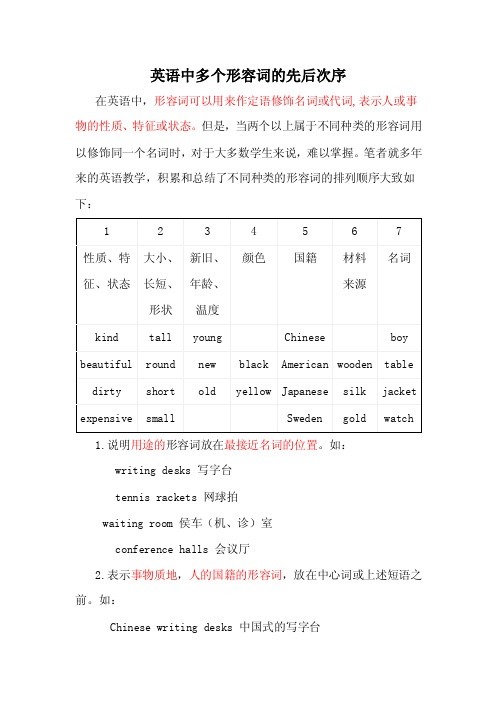
英语中多个形容词的先后次序在英语中,形容词可以用来作定语修饰名词或代词,表示人或事物的性质、特征或状态。
但是,当两个以上属于不同种类的形容词用以修饰同一个名词时,对于大多数学生来说,难以掌握。
笔者就多年来的英语教学,积累和总结了不同种类的形容词的排列顺序大致如下:1.说明用途的形容词放在最接近名词的位置。
如:writing desks 写字台tennis rackets 网球拍waiting room 侯车(机、诊)室conference halls 会议厅2.表示事物质地,人的国籍的形容词,放在中心词或上述短语之前。
如:Chinese writing desks 中国式的写字台steel and nylon tennis rackets 钢架尼龙网球拍Japanese writer 日本作家Chinese worker 中国工人Spanish leather boots 西班牙皮靴brick conference halls 砖结构会议厅3.表示新旧的形容词在前,表示颜色的形容词在后,都放在上述1和2两类短语之前。
如:black desks 黑色的书桌black writing desks 黑色写字台black Chinese writing desks中国式的黑色写字台old black Chinese writing desks 中国式的黑色的旧写字台new green Chinese glass ashtrays 中国式的绿色玻璃烟灰缸4.描写性的形容词,放在上述短语之前。
如:famous Japanese writer 著名的日本作家nice new white cap 漂亮的新的白色帽子ugly old brown Spanish leather boots 难看而破旧的棕色皮靴famous Japanese writer 著名的日本作家5.表示大小的形容词在前,表示形状的形容词在后,放在上述各类短语之前。
名词前的形容词顺序
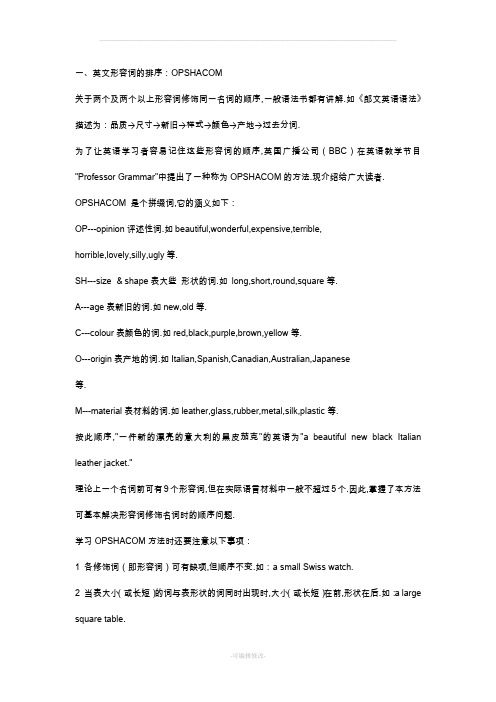
一、英文形容词的排序:OPSHACOM关于两个及两个以上形容词修饰同一名词的顺序,一般语法书都有讲解.如《郎文英语语法》描述为:品质→尺寸→新旧→样式→颜色→产地→过去分词.为了让英语学习者容易记住这些形容词的顺序,英国广播公司(BBC)在英语教学节目"Professor Grammar"中提出了一种称为OPSHACOM的方法.现介绍给广大读者. OPSHACOM 是个拼缀词,它的涵义如下:OP---opinion评述性词.如beautiful,wonderful,expensive,terrible,horrible,lovely,silly,ugly等.SH---size &shape表大些形状的词.如long,short,round,square等.A---age表新旧的词.如new,old等.C---colour表颜色的词.如red,black,purple,brown,yellow等.O---origin表产地的词.如Italian,Spanish,Canadian,Australian,Japanese等.M---material表材料的词.如leather,glass,rubber,metal,silk,plastic等.按此顺序,"一件新的漂亮的意大利的黑皮茄克"的英语为"a beautiful new black Italian leather jacket."理论上一个名词前可有9个形容词,但在实际语言材料中一般不超过5个.因此,掌握了本方法可基本解决形容词修饰名词时的顺序问题.学习OPSHACOM方法时还要注意以下事项:1 各修饰词(即形容词)可有缺项,但顺序不变.如:a small Swiss watch.2 当表大小(或长短)的词与表形状的词同时出现时,大小(或长短)在前,形状在后.如:a large square table.3 定冠词、不定冠词、指示代词、形容词性所有格、数词等位于句首.4 数词位于定冠词、指示代词后.(数词不与不定冠词或形容词性所有格连用)5 分词最靠近所修饰的名词.如:his new Japanese timing device;three scottish handmade skirts.下面请读者做几道练习题:用OPSHACOM法将下列各题括号中的单词按正确顺序排列:1.(Canadian ,extraordinary ,an ,new)play2.(green,a,large)garden3.(gold,British,the,round)coin4.(ugly,writing,the,steel,seven)desks5.(purple ,Russian ,nice ,long ,her)coat答案:1.an extraordinary new Canadian play2.a large green garden3.the round British gold coin4.the seven ugly steel writing desks5.her nice long purple Russian coat二、口诀法:“美小圆旧黄,中国木书房”在外语学习中,记忆是一个非常重要的环节.和外语相比,学生一般对自己母语更敏感,记忆母语更容易,印象更深刻.当学生在记忆外语词汇或语言知识时,总喜欢将其与母语挂钩.教师应结合具体情况利用母语帮助学生理解记忆.例如学生对名词前的修饰语的顺序弄不清,考试中经常出错.利用下面替代字组成的句子帮助记忆,教学效果就比较好.“美小圆旧黄,中国木书房”.注:“美”代表“描述或性质类”形容词;“小”代表“大小、长短、高低、胖瘦类”形容词;“圆”代表“形状类”形容词;“旧”代表“新旧、年龄类”形容词;“黄”代表“颜色类”形容词;“中国”代表“来源、国籍、地区、出处类”形容词;“木”代表“物质、材料、质地类”形容词;“书”代表“用途、类别、功能、作用类”形容词;“房”代表“中心名词”.例如:two beautiful new green silk evening dress 两件又新又漂亮的丝绸女士晚礼服;that hungry, tired, sleepy little match girl 那个饥饿、疲劳、困倦的卖火柴的小女孩;an old large brick dining hall 一个旧的红砖砌的大餐厅.三、巧记形容词排列顺序请看下面一道高考题:This____girl Linda"s conusin.(2005北京卷)A. pretty little SpanishB. Spanish little prettyC. Spanish prettyD. liite pretty Spanish此题选A. 该题时对形容词排列顺序的考察.在英语中,当名词有多个形容词修饰时,就有它们的先后顺序.下面的口诀可帮你记住这一先后顺序,也是解题的关键.限定描绘大长高,形状年龄和新老;颜色国籍跟材料,作用类别往后靠;其中,“限定词”包括:冠词、物主代词、指示代词、或数词,它位于各类形容词前.它本身分为三位,即:前、中、后.前位限定词有all、half、both、分数和倍数;中位限定词有冠词、指示代词、物主代词等;后位限定词有基数词和序数词,但序数词位于基数词前.如:both my hands、all half his income等.“描绘”性形容词如:beautiful、bad、cold、great等.“大长高”表示大小、长短、高低等一些词.表示“形状”的词如:round square等.“国籍”指一个国家或地区的词.“材料”的词如:wooden, woolen, stone,silk等.“作用类别”的词如:medical, college,writing desk,police car等.另一口诀:县官行令杀国材.县,表示限定词;官,指的是冠词;行,表示性质的定语;令,表示年龄;杀,表示颜色;国,表示国籍;材,表示材料.你有兴趣的话,不妨也试试编个"顺口溜"玩玩.四、熟记规则:大小形状和新老,颜色国际出(处)材料多个形容词修饰同一名词时的顺序是固定的,其顺序为:①冠词、指示代词、不定代词、物主代词+②序数词+基数词+③一般性描绘形容词+④大小、长短、形状+年龄、新旧+⑥颜色+⑦国籍、出处+⑧材料+⑨用途、类别+⑩最终修饰的名词或动名词.例如:a beautiful little red flower 一朵美丽的小花. those four old-looking,grey,wooden houses 所以这个翻译题我有一个中国制造木制红色的大的园桌子可以翻译成i have a big,round ,red,wooden,chinese table形容词的次序有一个口诀.可以记下来:大小形状和新老,颜色国际出(处)材料请根据形容词排列规则完成以下练习:1.she has a ___ jacket.(leather,brown,beautiful)2.he has a ___ car. (american,long,red)3.they live in a ___ house. (old,beautiful)4.we have a ___ table. (antique,small,wooden)5.he has a ___ jumper. (woollen, lovely, red)6.she has a ___ ring. (diamond,new,fabulous)7.it was a ___ song.(french,old, lovely)8.he owns a ___ dog.(black,horrible,big)9.she bought a ___ scarf.(gorgeous,silk,pink)10.i saw a ___ film. (new,fantastic, british)答案:1.beautiful brown leather jacket. 2.long red american car. 3.beautiful old house.4.small antique wooden table.5.lovely red woollen jumper.6.fabulous new diamond ring.7.lovely old french song. 8.horrible big black dog. 9.gorgeous pink silk scarf. 10.fantastic new british film.Welcome To Download !!!欢迎您的下载,资料仅供参考!。
多个形容词修饰名次顺序

多个形容词修饰名次的顺序:限定词+观点形容词+描绘形容词+中心名词观点形容词:cute,beautiful《郎文英语语法》描述形容词分为:品质→尺寸→新旧→样式→颜色→产地→过去分词观点形容词+描绘形容词:He has beautiful brown eyes.cute spoken nice to look at – used about animals, babies, children,and young adultsa cute little puppypretty pleasant to look at – often used about things that are not big or impressivea pretty little pink dress英国广播公司(BBC)在英语教学节目”Professor Grammar”中提出了一种称为OPSHACOM 的方法OP-—-opinion评述性词.如beautiful,wonderful,expensive,terrible,horrible,lovely,silly,ugly等.SH—--size &shape表大些形状的词。
如long,short,round,square等。
A—-—age表新旧的词.如new,old等。
C--—colour表颜色的词.如red,black,purple,brown,yellow等.O-——origin表产地的词.如Italian,Spanish,Canadian,Australian,Japanese 等。
M-—-material表材料的词。
如leather,glass,rubber,metal,silk,plastic等.a beautiful new black Italian leather jacket。
理论上一个名词前可有9个形容词,但在实际语言材料中一般不超过5个.因此,掌握了本方法可基本解决形容词修饰名词时的顺序问题.学习OPSHACOM方法时还要注意以下事项:1 各修饰词(即形容词)可有缺项,但顺序不变。
英语形容词的排序顺序总结及练习题含答案定稿版

英语形容词的排序顺序总结及练习题含答案精编W O R D版IBM system office room 【A0816H-A0912AAAHH-GX8Q8-GNTHHJ8】英语形容词排列英语形容词的排序有一定的难度,有人归纳出这样的规律口诀,可以试一试。
大哥限描大,二哥形龄颜,小弟籍物类,同站名词前。
分别解释为:限:限定词。
the,my,a,this…数: 数词。
序数词在前,基数词在后。
first,third;four,fifty描:描绘性形容词。
brave,beautiful,lovely,nice…大:大小、高低、长短等形容词。
big,large,small…形:形状。
round,square…龄:年龄大小、新旧、年代等。
young,old,new…颜:颜色。
red,blue,green…籍:国籍、地区、出处。
Chinese,America,Japanese…物:物质材料的形容词。
golden,wooden,wax…类:表示类别、用途。
medical,chemical,writing…一、大长高新颜国材例:thosethreebeautifullargesquareoldbrownwoodentable 二、大小形状和新老,颜色国际出(处)材料例:aprettylittlesquareoldblackJapanesewoodenwritingdesk 三、美小圆旧黄,中国木书房美:描述或性质类;小:大小、长短、高低、胖瘦类;圆:形状类形容词;旧:新旧、年龄类形容词;黄:颜色类形容词;中国:来源、国籍、地区、出处类形容词;木:物质、材料。
例:abeautifulshortnewredChinesewoolencoat一个旧的很漂亮的黑色的日本式的方形木制小写字桌AprettylittlesquareoldblackJapanesewoodenwritingdesk.一件漂亮的中式新的短装红羊毛外套AbeautifulshortnewredChinesewoollencoat.专业记忆?英文形容词的排序:OPSHACOM?关于两个及两个以上形容词修饰同一名词的顺序,一般语法书都有讲解。
名词前形容词的顺序口诀
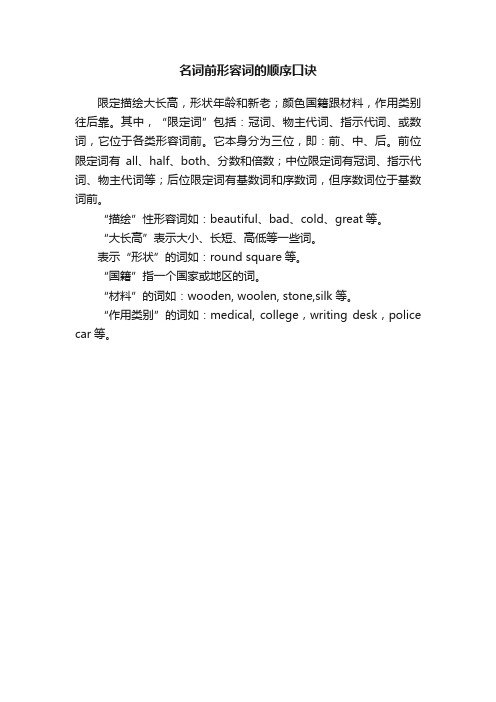
名词前形容词的顺序口诀
限定描绘大长高,形状年龄和新老;颜色国籍跟材料,作用类别往后靠。
其中,“限定词”包括:冠词、物主代词、指示代词、或数词,它位于各类形容词前。
它本身分为三位,即:前、中、后。
前位限定词有all、half、both、分数和倍数;中位限定词有冠词、指示代词、物主代词等;后位限定词有基数词和序数词,但序数词位于基数词前。
“描绘”性形容词如:beautiful、bad、cold、great等。
“大长高”表示大小、长短、高低等一些词。
表示“形状”的词如:round square等。
“国籍”指一个国家或地区的词。
“材料”的词如:wooden, woolen, stone,silk等。
“作用类别”的词如:medical, college,writing desk,police car等。
- 1、下载文档前请自行甄别文档内容的完整性,平台不提供额外的编辑、内容补充、找答案等附加服务。
- 2、"仅部分预览"的文档,不可在线预览部分如存在完整性等问题,可反馈申请退款(可完整预览的文档不适用该条件!)。
- 3、如文档侵犯您的权益,请联系客服反馈,我们会尽快为您处理(人工客服工作时间:9:00-18:30)。
名词前多个形容词的排列顺序
英语中多个形容词作前置定语,其词序不同于汉语。
总规则如下:
1、限定词
限定词位于各类形容词之首。
它本身分为三位。
即:前位、中位和后位,词序为前、中、后。
①前位限定词:有all, half, both, such 分数和倍数。
②中位限定词:有冠词,指示代词,形容词性物主代词,名词所有格和no,
every, each, either, neither, enough, much 等,以及wh-起首的限定词[what(ever), which(ever), whose 等]。
③后位限定词:有基数词和序数词,past, same, many, more, most, few, fewer, fewest, little, less, least, own 和last 等。
序数词在前,基数词后在。
例如:
I haven’t seen the vase
before.I like this pretty car.
2、描绘类
描绘类形容词表示事物的性质及人们的观点,先短词后长词。
如:cold, great, bad, beautiful kind, fine, interesting, good 等。
例如
I haven’t seen such a beautiful vase before.
I like the first two pretty cars.
3、形状类
形状类形容词表示大小、长短、高低(矮)、外形、干湿度等。
如:large, big, small, little, long, short, low, round, wet, dry 等。
例如:
I haven’t seen such a beautiful big vase before.
I like the first two pretty small cars.
4、时间类
时间类形容词表示年龄,长幼、时代,新旧、气候,温度等。
如:new, old, hot, new, little, old, young, cool, wet, dry 等。
例如:
I haven’t seen such a beautiful big round old vase
before.I like the first two pretty small square new cars.
5.颜色类
表示颜色的形容词有:brown, white, blue, black, pink, orange, grey 等。
例如:
I haven’t seen such a beautiful big round old white vase
before.I like the first two pretty small square new yellow cars.
6.出处类
出处类形容词表示国籍、地区、出处,产地、来源等。
如:Chinese, Australia, German, Asian 等。
例如:
I haven’t seen such a beautiful big round old white Chinese vase
before.I like the first two pretty small square new yellow Japanese cars.
7.材料类
材料类形容词表示物质、材料,质地等。
如:wooden, stone, silk, golden, steel 等。
例如:
I haven’t seen such a beautiful big round old white Chinese wooden vase before.
I like the first two pretty small square new yellow Japanese sports cars.
8.用途类
用途类形容词表示作用、类别。
如:medical, writing, police 等。
例如:
This is a a large famous medical school.
I like the valuable old Japanese writing desk
9、作定语的名词、动名词。
如:boy, girl, man, woman 等。
注:在实际运用中须注意:
1.如两个以上相同种类的形容词同时修饰一个中心词时,其间可用连词and 或but 连接,或用逗号分开。
如:a yellow, black sports car
2.如要强调某一种类的形容词时,可将所强调的形容词后移,同时用逗号分开。
如:a tall, dark, handsome cowboy
3、次序大致,但不绝对。
如:Those three beautiful large square old brown wood table, a heavy black Chinese steel umbrella, the man’s first tow interesting little red French oil paintings.
4. 实际上很少出现按上述一至九条规则组合全的名词性词组,因为太累赘。
但“无规矩不成方圆”,规则还是规则,规则必须掌握。
下面这首口诀可能便于记忆:
限定描绘大长高;形状年龄和新老;颜色国籍跟材料;作用类别往后靠。
【练习】
I、请按正确的顺序重新安排下列修饰语:
1.(brown, those, all, snakeskin, smart) shoes
2.(eating, the, all, green, sour) apples
3.(German, brown and white, large, antique) beer-mugs
4.her (round, small, pink) face
5.Louise's (evening, long, blue, famous) gown
6.a very ( old, valuable, gold) watch
7.a(n) (tennis, steel and nylon, expensive) racket
8.a (black, shiny, small, leather) handbag
9.several (red, pickling, large) cabbages
10.a (purple, pretty, silk) dress
Key:
1.all those smart brown snakeskin shoes
2.all the sour green eating apples
rge antique brown and white German beer-mugs
4.her small round pink face
5.Louise's famous long blue evening gown
6.a very valuable old gold watch
7.an expensive steel and nylon tennis racket
8.a small shiny black leather handbag
9.several large red pickling cabbages
10.a pretty purple silk dress
II. 请根据形容词排列规则完成以下练习:
1.She has a jacket.(leather,brown,beautiful)
2.He has a car. (American,long,red)
3.They live in a house. (old, beautiful)
4.We have a table. (antique, small, wooden)
5.He has a jumper. (woollen, lovely, red)
6.She has a ring. (diamond, new, fabulous)
7.It was a song.(French,old, lovely)
8.He owns a dog.(black, horrible, big)
9.She bought a scarf.(gorgeous, silk, pink)
10.I saw a film. (new, fantastic, British)
Key:
1.beautiful brown leather jacket.
2.long red American car.
3.beautiful old house.
4.small antique wooden table.
5.lovely red woollen jumper.
6.fabulous new diamond ring.
7.lovely old French song.
8.horrible big black dog.
9.gorgeous pink silk scarf.
10.fantastic new British film.。
